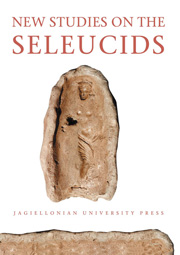Book contents
- Frontmatter
- Contents
- Abbreviations
- Local and Imperial Dates at the Beginning of the Hellenistic Period
- Europos-Doura Séleucide
- Suse et les Séleucides au IIIE siècle avant J.-C.
- Fondazioni di Antioco I Soter in Caria (St. Byz. s.v. Antiocheia)
- Antioco III e la politica onomastica dei Seleucidi
- Wie man ein „Verwandter“ des Königs wird – Karrieren und Hierarchie am Hofe von Antiochos III
- Achaeus, the Ptolemies and the Fourth Syrian War
- Imago mundi: expression et représentation de l'idéologie Royale séleucide. La procession de Daphné
- Nuove considerazioni sul Calendario Cappadoce. Persistenze e adattamenti dell'eredità achemenide nella storia di un piccolo regno tra mondo macedone, seleucide, attalide, partico e romano
- Demetrius III in Judea
- Reviews
Antioco III e la politica onomastica dei Seleucidi
Published online by Cambridge University Press: 05 September 2014
- Frontmatter
- Contents
- Abbreviations
- Local and Imperial Dates at the Beginning of the Hellenistic Period
- Europos-Doura Séleucide
- Suse et les Séleucides au IIIE siècle avant J.-C.
- Fondazioni di Antioco I Soter in Caria (St. Byz. s.v. Antiocheia)
- Antioco III e la politica onomastica dei Seleucidi
- Wie man ein „Verwandter“ des Königs wird – Karrieren und Hierarchie am Hofe von Antiochos III
- Achaeus, the Ptolemies and the Fourth Syrian War
- Imago mundi: expression et représentation de l'idéologie Royale séleucide. La procession de Daphné
- Nuove considerazioni sul Calendario Cappadoce. Persistenze e adattamenti dell'eredità achemenide nella storia di un piccolo regno tra mondo macedone, seleucide, attalide, partico e romano
- Demetrius III in Judea
- Reviews
Summary
Una lettera di Antioco III, proveniente da Eraclea sul Latmo e databile tra il 197 e il 193 a.C., ha fatto definitiva chiarezza su quali fossero i nomi di tre figli maschi del sovrano: Antioco, Seleuco e Mitridate. La loro identità è facilmente identificabile: Antioco è denominato nelle fonti ‘il figlio’ e fu coreggente del padre fino alla sua morte nel 193; Seleuco è conosciuto come Seleuco IV Philopator (sovrano dal 187 al 175) e il terzo, dopo opportuno cambio di nome, è noto come Antioco IV Theos Epiphanes Nikephoros (re dal 175 al 164).
Tuttavia un passo di Livio sembra complicare questo quadro, giacché lo storico patavino aggiunge un altro nome, Ardys (accanto a quello di Mitridate), a proposito della spedizione in Asia Minore del 197 di Antioco III. Anche se alcuni tra i moderni sono disposti ad ammettere l'esistenza di un quarto figlio maschio a nome Ardys, è comunque prevalente l'opinione che l'autore romano sia incorso in un fraintendimento (o che il testo tràdito vada emendato) e che dunque Ardys e il Mitridate nel luogo in questione non siano fratelli di Antioco e Seleuco, bensì due alti generali mandati in aiuto dei due figli del sovrano (Seleuco e Mitridate). Il nome del primo rivela una chiara origine non greca, forse una provenienza lidia, mentre il secondo, a quanto riferisce Polibio, era figlio di una non meglio precisata sorella di Antioco III e aveva combattuto nella guerra contro Serse d'Armenia; dal nome si può desumere che il padre appartenesse a qualche famiglia o dinastia di ceppo iranico.
- Type
- Chapter
- Information
- New Studies on the Seleucids , pp. 81 - 96Publisher: Jagiellonian University PressPrint publication year: 2011



